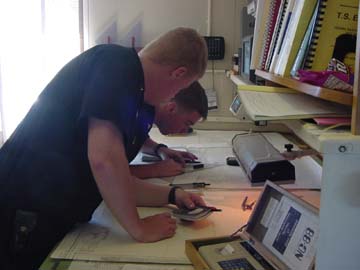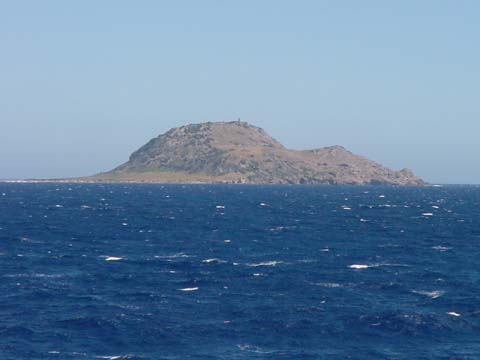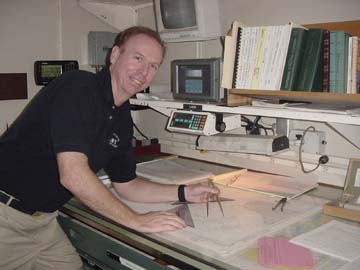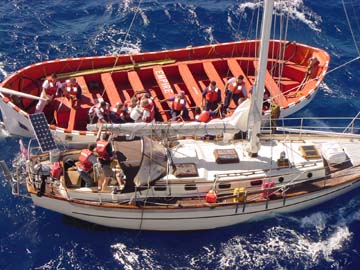
| February 2002 | ||||||
| Sun | Mon | Tue | Wed | Thu | Fri | Sat |
| 1 | 2 | |||||
| 3 | 4 | 5 | 6 | 7 | 8 | 9 |
| 10 | 11 | 12 | 13 | 14 | 15 | 16 |
| 17 | 18 | 19 | 20 | 21 | 22 | 23 |
| 24 | 25 | 26 | 27 | 28 | ||
Tuesday 12 February 2002
At 1200, EST the Training Ship Empire State was located 20 nautical miles northeast of Puero Plata, 19 degrees and 56 minutes North Latitude and 070 degrees 23 minutes West Longitude, steering course 290 degrees true at a speed of 10.5 knots/Rpm 48 turns. The weather was excellent with a few clouds, winds from the east at 10 to 15 knots, air temperature was 84 degrees Fahrenheit, barometric pressure was 1020 millibars, seas were easterly at 3 to 5 feet, sea injection temperature was 78 degrees Fahrenheit. Depth of water beneath the keel was 3000 meters.
CAPTAIN'S LOG
"Nothing makes the earth seem so spacious as to have friends at a distance: they make the latitudes and longitudes."
Henry David Thoreau
We spent a quiet evening transiting Mona Passage and moving into the Brownson Deep where water depths of more than 4,700 fathoms are recorded. Not far off shore, when one can almost see the sandy beaches that lay at the base of 300-foot cliffs to the south, the ocean floor abruptly drops more than five miles into an abyss. Just imagine testing your new SUV in that type of rugged mountain terrain.

Then we turned hard to port and steered between Hispanolia and the southern end of the Bahamas. I decided to travel to the inside (south) of the Bahamas, between Great Inagua Island and Cuba, Northwest through the old Bahama Channel, into the Straits of Florida, and north to Fort Lauderdale. The planned track keeps us close in, provides some shelter from potential Atlantic storms, and makes the Cadets think about every move. But the decision was not all business; there is something pleasant about staring off at passing islands, many unhabited, and dreaming about the ancient mariners who may have stopped there and wondering why. It is safe to say that they did not come for an enchanting Caribbean vacation or to watch the whales.

The Sea term generally takes on a slightly surrealistic mood at this point when the expectations of totally new places is behind them. One hears cadets and crew alike, talk increasingly about Buzzards Bay and the warmth of home, and less about the excitement of foreign port of call. Of course, many have been away from Buzzards Bay longer than ever before. Couple that with the confines of shipboard life and the inordinate demands of Sea Term and one does not have to be a genius to realize that thoughts of home are only natural. I resist the tendency to point out that this trip is far shorter than the normal work rotation in the merchant service. Old salts we are! But, if anyone says that he does not think of home, he is being less than honest. Fort Lauderdale will break the horizon before we know it, and the anchorage at Cape Cod Bay is just the other side of Hatteras.

However, for now we are moving through an amazingly beautiful part of the world and we are thankful for it. We are just south of the Mouchoir and Silver Banks today, near an area that has been designated the Marine Mammals Sanctuary of the Dominican Republic. The Silver Bank is part of a network of coral reefs that extends southeast to the Navidad Bank that we passed during the night. The waters among the coral is crystal clear, well protected from the battering of heavy waves and strong winds, and teeming with sealife. The environment is perfect for humpback whales and they come here every winter to breed and calve. The whales choose this site because it is dangerous for sailors and they are intelligent enough to know that. Some of their ancestors no doubt chuckled when an unfortunate vessel, the Conception, laden with mega silver and gold, sank here in 1641. Now you know the rest of the story...We are near the namesake "Silver Bank" and headed for the house.
See you tomorrow at Point Lucrecia, Cuba. Note: Here is a picture of the sailboat that we assisted into port last week:

CADET'S COMMENT
Not Just Another Day By Cadet 3/C Annie Paskavitch
I set my alarm for 0700 on Friday, February 8, but didn't actually roll out of bed until 0730. Here on the TSES, it is understood by one and all that sleep is much needed and well deserved, many times chosen over a meal.

The bus to Phosphorescence Bay would depart the dock at 0800, so that left plenty of time to get ready. After all, what more could one possibly need but a bathing suit, sun block, and a few dollars to buy some souvenirs for the family.
Fifty or so cadets piled on the bus ready for a day of adventure and excitement. The forty-minute ride soon turned into one and a half hours as we hit relentless traffic. Apparently, they do things differently in Puerto Rico with roadwork and construction routinely completed in the middle of the day rather than at night when fewer people are on the roads. Some cadets became restless, but the majority used the extra time to take a nap and catch up on lost sleep. After we turned onto the street with the marina, a few noticed the quaint little shops, some noticed the little restaurants that were tucked away along the street, but most noticed the signs that read: Beer $1.
After a short break, we boarded three boats loaded with diving gear and headed out to go snorkeling. But, just after pulling away from the dock, one of the boats lost steering and was forced to return. The two remaining boats continued to the island where we ate lunch and swam while waiting for the rest of the group to arrive. I hoped for nothing more than a nice sandy beach to stretch out, but after stubbing my toes the sharp coral, that image soon faded. It was absolutely breath taking though, the water was clear Caribbean blue, just warm enough to be refreshing on a hot day, with tropical fish darting around everywhere. Since I had not snorkeled before, I decided to take a test run with a few friends nearby. I almost turned back when a friend pointed to all of the black sea urchins; with my luck, of course they are poisonous. I saw so many brightly colored fish and I even encountered a gigantic starfish unlike any that I had seen before. I also discovered a pair of sunglasses on the very bottom of the bay that must have been there from the 1980's. I just couldn't pass them up so I dove down and retrieved them. Finally, the boat arrived with the remaining cadets and after a quick swim, we were on our way to the reef. We soon discovered that there was enough equipment for only half of the people. Although disappointing, it was obvious that we would share even though that meant less time snorkeling for everyone. The day seemed to be getting off rather slowly and some cadets became irritated with the delays. Then suddenly we remembered, we're in Puerto Rico with all of our friends earning school credits while in the meantime, those back home are freezing from the ice storms and the snow. That thought was enough to keep a smile on every face. At 1600, we shuttled back to the mainland to grab a quick bite to eat and gather for an evening cruise to Phosphorescence Bay. Once ashore, most of the guys played pool, listened to music, and enjoyed cold drinks at the local bar. However, many of the females found that money was burning holes in their pockets, and the cute shops nearby were perfect places to spend it.
The cruise was to start at 1830 but the time came and went and we waited for more than an hour before the boat captain arrived but we were finally away from the dock once more, morale was high, and everyone enjoyed the brief ride out into the bay. The captain turned all of the lights off, the water glowed magnificent fluorescent green, and we anchored. No one could believe their eyes, within minutes, cadets were cannon balling from all sides of the boat, and the roof just to see how bright the water would be when they splashed down. It was amazing, people swimming around the boat engulfed in sparkles; it appeared to me that there was a light at the bottom of the ocean shining up on them. Everyone noticed how clear the night sky was, and just how many stars were visible. The day may have started a little rocky, but none of that mattered anymore as we splashed around in the moonlight with Phosphorescence sea stars sparkling around us. We had a great time for everyone knew that this is as close to heaven as one can get.
QUESTIONS FOR WEDNESDAY 13 FEBRUARY 2002
MATH: Cadets want to mix a batch of window cleaner. Ten ounces of the concentrated solution contains 20 percent ammonia and 80 percent water. They plan to dilute it with 40 ounces of water. What is the percent of ammonia in the new solution?
SCIENCE: Cadets produce electricity aboard Empire State. The machine that they use produces electric current by rotating loops of wire through a magnetic field. What is this machine called?
GEOGRAPHY: This is a question to see if you have been paying attention to the Captain's Log: The Master of the Empire State reports the weather on a daily basis. Have you been noticing what direction the wind comes from? What is the wind direction almost every day? These winds have a special name, what is it?
HISTORY: An individual we have all come to love to hate is named Edward "Teach", or more accurately, "Thatch." He and his band of outlaws operated in the Atlantic Ocean ranging from the southern Leeward Islands to Virginia. He was known to seek safety, with others of his type, in the port of Providence in the Bahamas. Who was this feared mariner who plundered ships during the early 1700's (between 1715 and 1718)?
ANSWERS FOR TUESDAY 12 FEBRUARY 2002
MATH: 2.6 x 7 x 60 = 1092 minutes
SCIENCE: Density
GEOGRAPHY: The line is called the Tropic of Cancer. You will see it drawn on a map located just north of Cuba. You will not see it if you sailed over the line in a boat.
HISTORY: Haiti